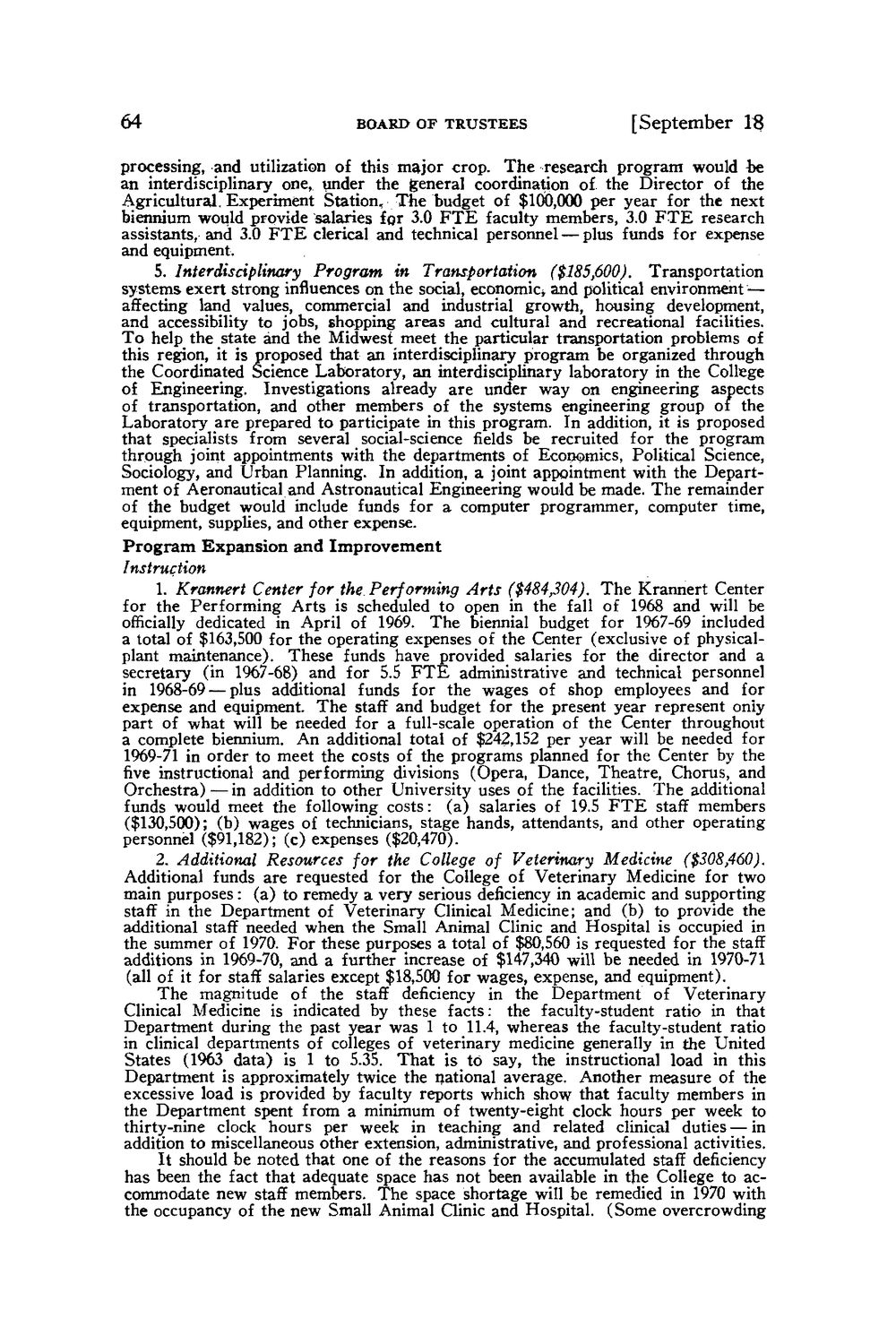| |
| |
Caption: Board of Trustees Minutes - 1970
This is a reduced-resolution page image for fast online browsing.

EXTRACTED TEXT FROM PAGE:
64 BOARD OF TRUSTEES [September 18 processing, and utilization of this major crop. T h e research program would be an interdisciplinary one, under the general coordination of the Director of the Agricultural. Experiment Station, T h e budget of $100,000 per year for the next biennium would provide salaries for 3.0 F T E faculty members, 3.0 F T E research assistants, and 3.0 F T E clerical and technical personnel — plus funds for expense and equipment. 5. Interdisciplinary Program in Transportation ($185,600). Transportation systems exert strong influences on the social, economic^ and political environment — affecting land values, commercial and industrial growth, housing development, and accessibility to jobs, shopping areas and cultural and recreational facilities. T o help the state and the Midwest meet the particular transportation problems of this region, it is proposed that an interdisciplinary program be organized through the Coordinated Science Laboratory, an interdisciplinary laboratory in the College of Engineering. Investigations already are under way on engineering aspects of transportation, and other members of the systems engineering group of the Laboratory are prepared to participate in this program. In addition, it is proposed that specialists from several social-science fields be recruited for the program through joint appointments with the departments of Economics, Political Science, Sociology, and Urban Planning. In addition, a joint appointment with the Department of Aeronautical and Astronautical Engineering would be made. The remainder of the budget would include funds for a computer programmer, computer time, equipment, supplies, and other expense. P r o g r a m Expansion and Improvement Instruction 1. Krannert Center for the Performing Arts ($484,304). T h e Krannert Center for the Performing Arts is scheduled to open in the fall of 1968 and will be officially dedicated in April of 1969. The biennial budget for 1967-69 included a total of $163,500 for the operating expenses of the Center (exclusive of physicalplant maintenance). These funds have provided salaries for the director and a secretary (in 1967-68) and for 5.5 F T E administrative and technical personnel in 1968-69 — plus additional funds for the wages of shop employees and for expense and equipment. T h e staff and budget for the present year represent oniy part of what will be needed for a full-scale operation of the Center throughout a complete biennium. An additional total of $242,152 per year will be needed for 1969-71 in order to meet the costs of the programs planned for the Center by the five instructional and performing divisions (Opera, Dance, Theatre, Chorus, and Orchestra) — in addition to other University uses of the facilities. The additional funds would meet the following costs: (a) salaries of 19.5 F T E staff members ($130,500); (b) wages of technicians, stage hands, attendants, and other operating personnel ($91,182); (c) expenses ($20,470). 2. Additional Resources for the College of Veterinary Medicine ($308,460). Additional funds are requested for the College of Veterinary Medicine for two main purposes: (a) to remedy a very serious deficiency in academic and supporting staff in the Department of Veterinary Clinical Medicine; and (b) to provide the additional staff needed when the Small Animal Clinic and Hospital is occupied in the summer of 1970. For these purposes a total of $80,560 is requested for the staff additions in 1969-70, and a further increase of $147,340 will be needed in 1970-71 (all of it for staff salaries except $18,500 for wages, expense, and equipment). The magnitude of the staff deficiency in the Department of Veterinary Clinical Medicine is indicated by these facts: the faculty-student ratio in that Department during the past year was 1 to 11.4, whereas the faculty-student ratio in clinical departments of colleges of veterinary medicine generally in the United States (1963 data) is 1 to 5.35. T h a t is to say, the instructional load in this Department is approximately twice the national average. Another measure of the excessive load is provided by faculty reports which show that faculty members in the Department spent from a minimum of twenty-eight clock hours per week to thirty-nine clock hours per week in teaching and related clinical duties — in addition to miscellaneous other extension, administrative, and professional activities. It should be noted that one of the reasons for the accumulated staff deficiency has been the fact that adequate space has not been available in the College to accommodate new staff members. The space shortage will be remedied in 1970 with the occupancy of the new Small Animal Clinic and Hospital. (Some overcrowding
| |